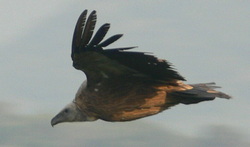 Griffon Vulture
Griffon Vulture 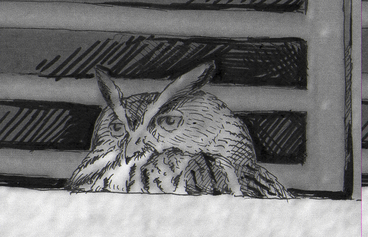 I sketched this Eagle Owl in Kent ... but you have a better chance in Spain!
I sketched this Eagle Owl in Kent ... but you have a better chance in Spain! 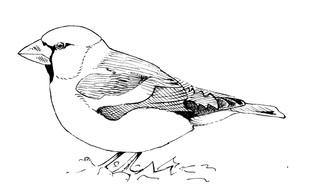 Hawfinch sketch
Hawfinch sketch 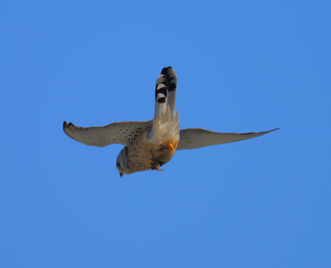 A male Lesser Kestrel battles against strong winds to stay put!
A male Lesser Kestrel battles against strong winds to stay put! 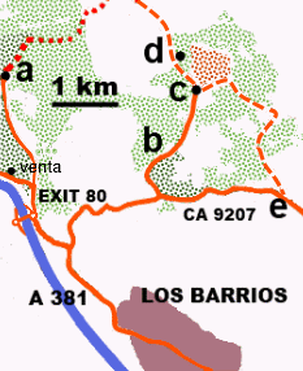 Los Barrios area - note minor corrections to earlier map
Los Barrios area - note minor corrections to earlier map | Birding Cadiz Province |
|
 Griffon Vulture Griffon Vulture I'm sure many birders have had the experience where non-birding friends express the opinion that 'you must visit some lovely places when you go birding'. This is certainly often the case and, one I couldn't possibly deny given that this article is about a particularly attractive part of Spain. However, such comments clearly show a lack of awareness of just how much time birdwatchers actually spend haunting less than salubrious sites like sewage farms and rubbish tips! Having read of the delights of Perry Oaks and Wisbech sewage farms, one of my regrets when growing up was that there wasn't a really decent, smelly sewage farm nearby to act as a Mecca for passing waders. Improvements in the treatment of sewage has relegated such wader magnets to ornithological history. Rubbish tips, of course, are more persistent feeding off our wasteful society, but in the UK they mainly attract gulls so unless you're a confirmed “lariphile” they don't hold much to attraction. Fortunately, they do things differently in Spain where large tips regularly attract Cattle Egrets, White Storks and raptors – lots of them! All good things, though, come with a price. In the UK it's a disagreeable whiff, but in Spain the price is proportionate – legions of innumerable buzzing flies and an olfactory assault course! An exaggeration? Perhaps, but on a hot still day it can require determination to stay for long. However the rewards, particularly for photographers, can be enormous.  I sketched this Eagle Owl in Kent ... but you have a better chance in Spain! I sketched this Eagle Owl in Kent ... but you have a better chance in Spain! One elusive and much sought after species is rumoured to be particularly attracted to rat infested rubbish tips – Eagle Owl. This fearsome hunter is roughly the size of a male Golden Eagle and is at the top of the nocturnal food chain. It will take a wide range of species and although overall rats only form 10% of its prey, for some individuals they may form over 80% of prey items. For such birds that specialise in 'ratting', rubbish tips must be close to Nirvana. Despite making a number trips to tips specifically in search of the species, my sole success was a complete fluke. Having got stuck in a massive traffic jam one evening whilst trying to leave Sanlucar, I unwisely attempted to cut across country and got hopelessly lost on the backroads not far from Puerto Real. As we drove along in the gathering gloom a huge bird suddenly got up from beside the road. That my instant thought was 'Griffon!' shows big it was, but as it flew through the headlight beams I realised it was an Eagle Owl. At the time it seemed an odd place to see one, but when drove the road again in daylight I realised it bordered a massive rubbish tip (see 'a' on Map 21 in my notes on NW 14.1 Salinas Santa Maria etc).  Hawfinch sketch Hawfinch sketch However, of all the tips I've ever visited in the pursuit of birds, by far the most impressive, birdwise, is that to be found above Los Barrios in Cadiz province (see map). Admittedly, several evening visits have failed to turn up an Eagle Owl, but the tip and surrounding areas never fail to impress. Driving south on the A381 you pass some impressive scenery before dropping down into the lowlands of the Campo de Gibraltar near Los Barrios. Many of the pylons next to the road here, and further south, have nesting White Storks - probably not unconnected with the availability of plentiful year round food courtesy of our wasteful habits. Peeling off the A381 at Exit 80, I often head back north along the service road Restaurante Venta El Frenazo (c1km); it's one of the best ventas in the area and serves distinctly above average tapas. Another bonus of doing so is that you can explore a minor road on the right just before the restaurant – I'm told that early in the morning (and presumably in the evenings) the area round the junction can be good for Hawfinch. In the UK this charismatic species has undergone a huge decline and it's population is now very fragmented. Apparently the population on the continent is 'stable'. In Spain they're largely restricted to cooler mountain regions (e.g.like the Sierra Morena), but, although described as 'common' the woodlands of Cadiz province I've found them fairly elusive. Particularly around roosting sites they can be picked up by their Robin like 'tick' call (see http://www.xeno-canto.org/153798); a 'Robin' calling from more than a few metres high will probably turn out to be a Hawfinch! If you continue to the end of the road (a on map) you can explore along a sendero.  A male Lesser Kestrel battles against strong winds to stay put! A male Lesser Kestrel battles against strong winds to stay put! Turning towards Los Barrios in just under a kilometer take the road uphill to your right which takes you up to the rubbish tip (see map). If you're unsure just follow the trail of rubbish that litters the verges, but take care as heavy lorries, some travelling at speed, thunder along this road! As you climb this road (b) it not only gives you terrific views across to Africa, but also, during migration periods, a good chance of seeing dozens of Lesser Kestrels hovering along the ridge or perhaps a massive Short-toed Eagle. In autumn many of the latter are the pale whitish immatures (the origin I assume of the eagle's French name Jean-le-Blanc). Interestingly recent research has shown that young birds on migration through the straits have a very different diet from adults. Extraordinarily, the young of these massive birds have a diet largely consisting of centipedes and, to a lesser extent, praying mantises. Presumably this is due to their inability, as inexperienceed hunters, to compete with adults for the more usual prey of snakes and reptiles.  Los Barrios area - note minor corrections to earlier map Los Barrios area - note minor corrections to earlier map After bearing left at a junction (3km), you reach the rubbish tip (c) where you can pull off on the track to your left to view the tip. (The track to the right doesn't offer such a "good" view and is heavily used by lorries so is best avoided). The stench here is almost unbearable at times although I'm told it's better than it used to be! It's not so bad at weekends when the tip isn't in use, but then there are fewer birds. In the open sheds, crammed with insalubrious looking detritus, Cattle Egret and White Stork enthusiastically pick amongst the rubbish for choice morsels. Both, but particularly the storks, are often stained and dirty – fittingly, given the legendary origin of the word, looking quite 'isabelline'! This year round cornocopia of food is probably a major factor in the local storks' increasing reluctance to move away from the area in the winter. The egrets and storks are often joined as they perch on the roof by dozens of Black Kites …. and this is the place to see this species. At times during migration periods literally thousands are attracted to the free sushi bar for kites. If, unlike me, you're a decent photographer birds drifting low over the road can give you a great opportunity for getting some good shots – and if you miss your first chance, don't worry as another will be along shortly! Griffons and, less frequently, Egyptian Vultures also frequently pass overhead at close range. Unfortunately, these big birds tend to drop down at some distance from the track (previously, apparently, they were closer to the fence) which means you'll need a 'scope to scan any resting birds for Rüppell’s Vulture; during autumn migration you've as good a chance of this rare visitor here as anywhere, and probably better than most sites. Unlike elsewhere there's a fair chance that a visiting vulture will circle round for a little longer or even land. Pick a good day at that season and you'll also catch the stream of other raptors heading south. I've once had 18 species of raptor here in a couple of hours - 3 vultures (inc. Rüppell’s) and five falcons (inc. Lanner) plus hundreds of Honey Buzzards, Black Kites, Booted and Short-toed Eagles, etc., but I suspect that along the straits this isn't so unusual and some folks may even have reached a day total of twenty! If the stench becomes unendurable, then another kilometre along the track there's a low 'saddle' where you can pull over and watch raptors taking a short-cut to the back of the tip. The views across the Alcornocales from here are superb! Driving down from the tip you can return the way you came, perhaps diverting to the Restaurante Venta El Frenazo ; a good strong cup of coffee is a good way to drive out memories of the smell of the tip although you might find your appetite wanting. Alternatively cut east along the CA 9207 towards Estacion de San Roque and on to Jimena. It's not a route I've often taken, but the habitat looks interesting and worth a closer look.
0 Comments
Leave a Reply. |
About me ...Hi I'm John Cantelo. I've been birding seriously since the 1960s when I met up with some like minded folks (all of us are still birding!) at Taunton's School in Southampton. I have lived in Kent , where I taught History and Sociology, since the late 1970s. In that time I've served on the committees of both my local RSPB group and the county ornithological society (KOS). I have also worked as a part-time field teacher for the RSPB at Dungeness. Having retired I now spend as much time as possible in Alcala de los Gazules in SW Spain. When I'm not birding I edit books for the Crossbill Guides series. CategoriesArchives
May 2023
|